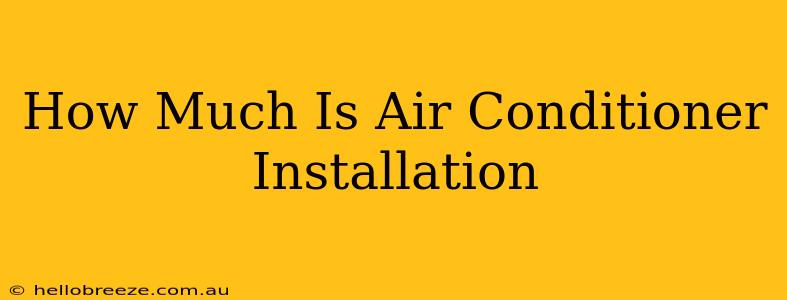Are you sweating over the thought of soaring summer temperatures? Investing in a new air conditioner is a smart move, but the cost of installation can feel daunting. This comprehensive guide breaks down the factors influencing the price of AC installation, helping you budget effectively and make informed decisions.
Understanding the Variables Affecting Air Conditioner Installation Costs
The price of installing an air conditioner isn't a one-size-fits-all figure. Several key factors play a crucial role:
1. The Type of Air Conditioner
The type of AC unit you choose significantly impacts installation costs. Here's a breakdown:
- Window Units: These are generally the cheapest to install, often requiring minimal professional intervention. You might even be able to DIY it, saving on labor costs.
- Portable Air Conditioners: These also tend to be easier and cheaper to install than central systems, but professional installation might be necessary for proper venting.
- Central Air Conditioning Systems: These are the most expensive to install, involving extensive ductwork, refrigerant lines, and potentially electrical upgrades. This is usually a job best left to experienced professionals.
- Split Systems (Mini-Splits): These are more complex than window units but less so than central systems. Installation involves connecting indoor and outdoor units, requiring professional expertise.
2. The Size of the Air Conditioner
Larger AC units generally mean higher installation costs. Larger units require more powerful electrical wiring, potentially necessitating upgrades to your home's electrical system. This adds to the overall expense. A properly sized unit is crucial for efficiency and comfort, so professional assessment is vital.
3. The Complexity of the Installation
The ease or difficulty of installation plays a massive role in the final price. Some factors contributing to complexity include:
- Existing Ductwork: If you're installing a central AC system, the presence or absence, and condition, of existing ductwork drastically alters the cost. New ductwork is considerably more expensive.
- Accessibility: Difficult-to-reach locations for the outdoor unit (e.g., third-floor installations) will naturally increase labor costs.
- Electrical Requirements: If your home's electrical system requires upgrades to accommodate the new AC unit, this will add significantly to the expense.
- Refrigerant Lines: The length and complexity of refrigerant lines needed to connect the indoor and outdoor units affect the cost of installation, especially for split systems and central AC.
4. Labor Costs
Labor costs represent a significant portion of the total installation price. Factors influencing labor costs include:
- Geographic Location: Installation costs vary widely depending on your location. Areas with higher labor costs will reflect higher prices.
- Professional vs. DIY: While DIY installation might seem cost-effective initially, mistakes can lead to more significant expenses down the line. Professional installation ensures a safe and efficient setup.
- Time of Year: During peak seasons (summer), demand is high, and labor costs tend to rise.
5. Permits and Inspections
Depending on local regulations, you might need permits for AC installation. Permit fees and inspection costs add to the overall expense. Check with your local building department to understand the necessary steps.
Estimating the Cost: A Range of Possibilities
While providing an exact figure is impossible without a specific assessment of your situation, here's a general range to give you a starting point:
- Window Units: $100 - $500 (DIY or minimal professional help).
- Portable Air Conditioners: $100 - $300 (DIY or basic installation).
- Split Systems (Mini-Splits): $2,000 - $8,000+.
- Central Air Conditioning Systems: $5,000 - $15,000+ (depending on size and complexity).
These are estimates, and the actual cost could be higher or lower depending on the factors discussed above.
Tips for Keeping Installation Costs Down
- Shop Around for Quotes: Get quotes from multiple reputable HVAC contractors to compare pricing and services.
- Consider Energy-Efficient Units: While the upfront cost might be slightly higher, energy-efficient units can save you money on energy bills in the long run.
- Schedule Installation During the Off-Season: Installation during the off-season (fall or winter) can often result in lower labor costs.
- Check for Rebates and Incentives: Some local utilities or government programs offer rebates or incentives for installing energy-efficient AC units.
Getting a new air conditioner is a big investment. By understanding the factors influencing installation costs, you can navigate the process effectively and choose the best solution for your budget and cooling needs. Remember to get multiple quotes and carefully consider all aspects of the installation before making a final decision.

